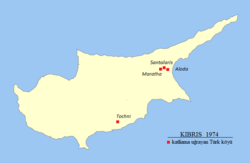Top Qs
Timeline
Chat
Perspective
Maratha, Santalaris and Aloda massacre
Massacres of Turkish Cypriots by Greeks and Greek Cypriots From Wikipedia, the free encyclopedia
Remove ads
Maratha, Santalaris and Aloda massacre (Turkish: Muratağa, Sandallar ve Atlılar katliamı) refers to a massacre[1][2][3][4][5] of Turkish Cypriots by EOKA B; a Greek Cypriot paramilitary group[4] that took place on 14 August 1974 in the villages of Maratha, Santalaris and Aloda.[6] In the massacre, a total of 126 unarmed Turks were killed, with the youngest being 16 days old and the oldest 95 years old.[7][8]
Remove ads
Background
According to the 1960 census, the inhabitants of the three villages were entirely Turkish Cypriots.[9] The total population of Maratha and Santalaris was 207.[10] By 1973, the total population of the villages had risen to 270, with 124 in Maratha, 100 in Santalaris and 46 in Aloda. However, in July 1974, following the first Turkish invasion of Cyprus, all men of fighting age were taken away as prisoners of war to internment camps in Famagusta and from there transferred to Limassol.[11][12] The Turkish Invasion of Cyprus started in response to a Greek junta-sponsored Cypriot coup d'état five days earlier, it led to the Turkish capture and occupation of the northern part of the island. On 2 July 1974, Makarios wrote an open letter to President Gizikis complaining bluntly that 'cadres of the Greek military regime support and direct the activities of the 'EOKA-B' terrorist organisation'. [13][failed verification]
Remove ads
Massacre
Summarize
Perspective
On 20 July 1974, the men of the villages were arrested by EOKA-B and sent to Limassol. Following this, according to testimonials cited by Sevgül Uludağ, EOKA-B men from the neighboring village of Peristeronopigi came, got drunk in the camp they established in the village coffeehouse, fired shots in the air, and subsequently raped many women and young girls; this continued until 14 August 1974. Upon the launch of the second invasion of the Turkish Army, they decided not to leave behind any witnesses and killed the entire population of the villages present at the time.[14][15]


In Maratha and Santalaris, 84-89 were killed. The Turkish imam of Maratha stated that there were 90 people in the village prior to the massacre, and only six people were left.[16] Elderly people and children were also killed during the massacre.[17] Only three people were able to escape from the massacre in Aloda.[1] The inhabitants of the three villages were buried in mass graves with a bulldozer. The villagers of Maratha and Santalaris were buried in the same grave.[1]
Associated Press described the corpses as "so battered and decomposed that they crumbled to pieces when soldiers lifted them from the garbage with shovels".[16] Milliyet reported that parts of the bodies had been chopped off and sharp tools, as well as machine guns had been used in the massacre.[18]
According to Greek Cypriot writer and researcher Tony Angastiniotis, at least one of the attackers used a mainland Greek accent, which suggested that he was a Greek officer.[19]
Remove ads
Reactions
The massacre was reported by international media, including The Guardian and The Times.[20]
Rauf Denktaş put off a meeting with Greek Cypriots after the mass grave was uncovered.[21]
See also
References
External links
Wikiwand - on
Seamless Wikipedia browsing. On steroids.
Remove ads


